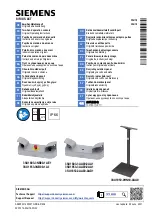
Thirdly, the way in which the name is
typed in indicates to the desk the
control mechanism required. For
example, if the fixture is a Par Can with
a colour scroller, which is a composite
type, it must be entered in the format of
scroller. The + symbol in
this field enables the control
mechanism to recognize that the fixture
requires two DMX start addresses, and
to allocate one to the Par Can and a
different one to the scroller. (The Par
Can and scroller are both subfixtures.)
VARIANT NUMBER
Currently unused, but will in the future
allow variants of a fixture to be
programmed together.
COMPOSITE FIXTURE
This is a fixture that needs more than
one DMX start address, which is
indicated by the + symbol in the
Fixture Type field. When a fixture type
containing at least one + is entered,
the components of the composite
fixture are set up as subfixtures.
SUBFIXTURE
This is a component part of a
composite fixture.
PARAMETERS
Each parameter in the fixture type has
to be classified under one of the
following attributes:
Brightness, Colour, Beamshape,
Position, Other
It is up to the operator to ensure that
the parameters are sensibly allocated
to the respective attributes, so that they
can be programmed together.
PARAMETER NAME
This text field is used to identify the
parameter (maximum 11 characters).
The text appears in the wheel display
when programming memories.
DATA TYPE
Parameters are usually controlled by
either one or two DMX channels. A
parameter controlled by a single DMX
channel is an eight bit or Byte
parameter (having a value range of 0
to 255). A parameter controlled by two
DMX channels is a 16 bit or Word
parameter (having a value range of 0
to 65535). Word parameters are
normally described as having a coarse
(MSB) and a fine (LSB) control. It is
important not to reverse these as this
makes control of the fixture very
confusing.
CHANNEL
This numeric field specifies the DMX
channel which controls the specific
parameter if the DMX start address for
the fixture is one. If the parameter is a
word parameter two channels (MSB
and LSB) must be supplied.
LEVEL DATA
A parameter can be set to either
Variable or Fixed to take account of the
fact that different types of parameters
are controlled in different ways.
The full range of DMX data values,
from 0 to 255 (or 0 to 65535 for a word
parameter) are used, if the parameter
is defined as variable.
With a Fixed parameter, only discrete
steps within the range are transmitted
to the output. For example, a colour
wheel with eight different positions can
be set to transmit only the eight DMX
values that select the eight colours. Or
it could be set to 16 positions so that all
whole and half colours are selected
(assuming that the fixture can stop
between colours).
If a parameters level data has been
set to Fixed, the Parameter Details can
be entered.
PARAMETER DETAILS
When a parameter is set to Fixed Level
Data the operator is able to enter a
detailed breakdown of the DMX range
for the parameter.
Taking a Colour wheel parameter as
an example, if a wheel has ten colours,
the first colour may be visible in a DMX
range of 0 to 25, the second 26 to 51,
the third 52 to 78, and so on to the last
colour and 255. Each range can be
given a separate name and a fixed
point (DMX value).
If the fixed point is defined that DMX
value will be transmitted on the DMX
output if the control input is within the
range, allowing the wheel only to snap
between the fixed points. If the fixed
point value is left empty then that
section of the range becomes variable,
allowing the wheel to stop at any
position within the range.
DEFAULT VALUE
A default value can be set for any
parameter. The default level is
normally set so that when Brightness is
turned up, the beam can be seen on
stage (i.e. iris open; colour to white;
pan and tilt to center position, etc.).
However, the defaults can be set to
any desired value. The Default values
for a fixture can be sent out on the
DMX while programming See find
function on page 3-6
5
n
Figure 5-19: Brightness Parameter Data
Set-Up: Fixture Set-Up
7364000/p21/3
5 - 21
Summary of Contents for SIRIUS 500
Page 1: ...SIRIUS 500 250 OPERATOR S MANUAL...
Page 3: ...ii...
Page 7: ...Pvi V3 TABLE OF CONTENTS vi 7364000 Pvi V3...
Page 15: ......
Page 30: ...p3 11 3 7364000 p3 11 3 3 11...
Page 57: ......
Page 67: ...p4 10 1...
Page 107: ......
Page 111: ......
Page 117: ......
















































